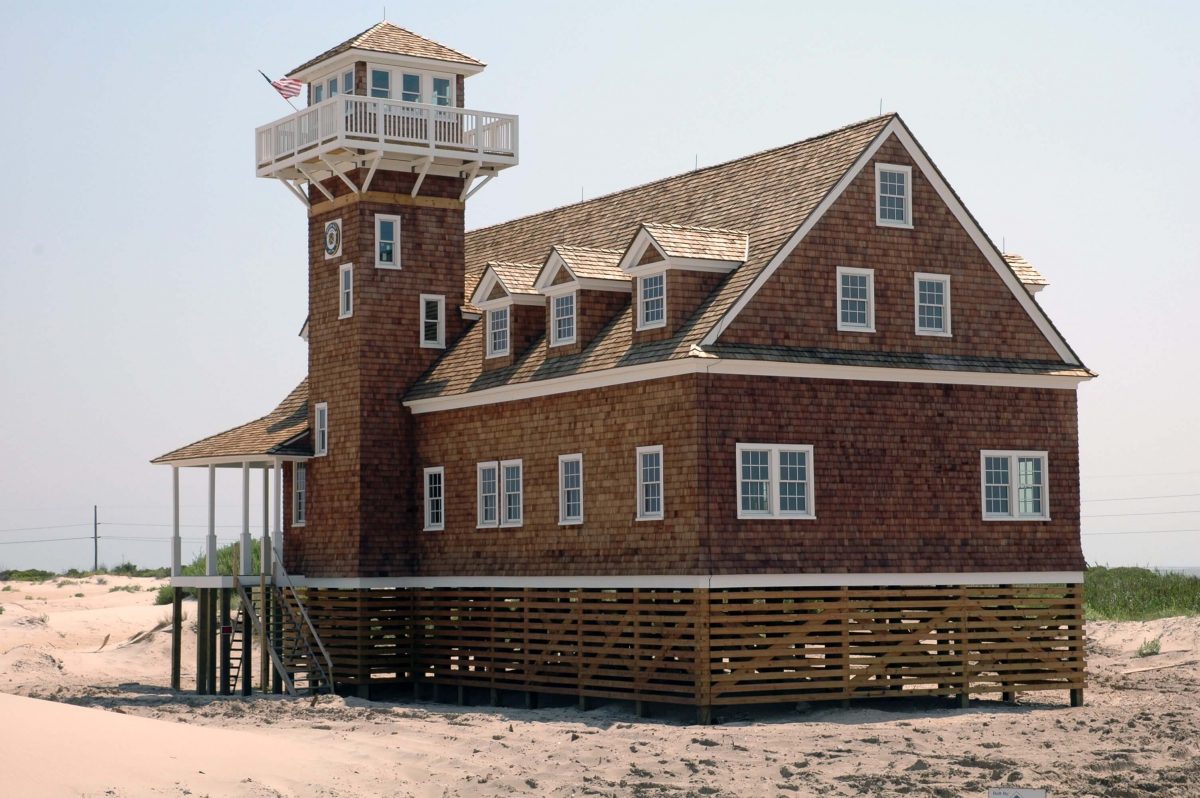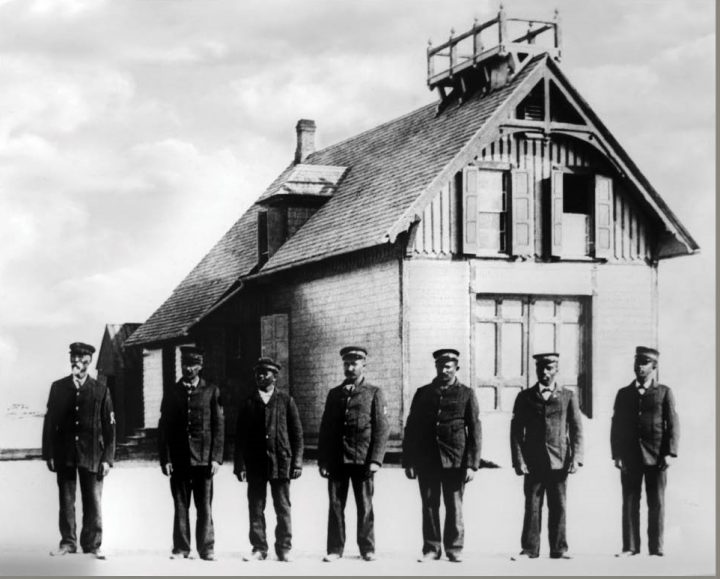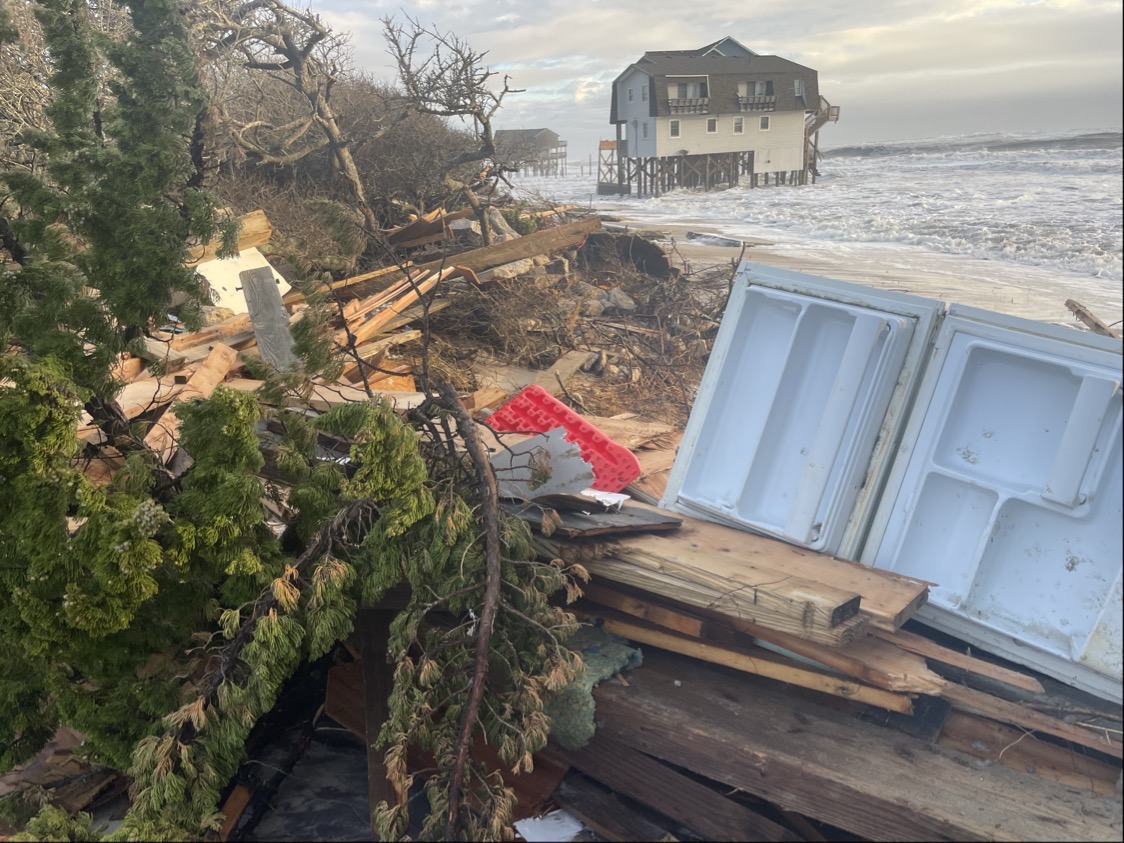
The Old Oregon Inlet Life-Saving Station is one of the most beautiful historic buildings on the Outer Banks, situated at a dramatic coastal location that would befit a movie setting.
But it’s got to go.
Supporter Spotlight
Where and when and to whom is what the North Carolina Aquariums — the building’s current owner — is trying to figure out.
“It’s a piece of history — we would really like to see it preserved,” Larry Warner, the director of N.C. Aquarium on Roanoke Island, recently told Coastal Review. “Our goal now is to move it.”

Built in 1898 for about $7,000 on a picturesque corner of beach between the Atlantic Ocean and the East Coast’s most unruly inlet, the station has not been in use since it was decommissioned by the U.S. Coast Guard in 1988. Standing exposed for decades on the northern tip of Pea Island National Wildlife Refuge, the deteriorating building was nearly buried in sand and a magnet for vandals.
In 2007-08, the state paid $7 million to elevate and renovate the structure, demolish 1970s-era dormitories, weatherize the building and restore its historic good looks.
Around that time, the North Carolina Aquariums system was planning to turn the site into a satellite facility for students and interns to study in what was envisioned as a marine and coastal wildlife research center on the Outer Banks.
Supporter Spotlight
“Then Jennette’s Pier jumped into the picture,” Warner said. “All the focus and all the funds went into the pier.”
With Jennette’s Pier in Nags Head since transformed into a major research/educational asset and attraction for the aquariums, the fate of the life-saving station was put on the back burner.
In the governor’s proposed fiscal 2022-23 budget, Warner said, the Aquariums requested $600,000 to relocate the station, potentially to a 16-acre site near the Roanoke Island aquarium. But the funds never made it into the final budget, and it’s not clear when or if another request will be submitted.
Although the Aquariums is seeking the move, it’s still open to where it might go.
“We are not married to the building coming over to the aquarium,” Warner said.
In addition to the station, the state owns 10 acres under and surrounding it. The Pea Island refuge, managed by the U.S. Fish and Wildlife Service, has an easement at the site for management of wildlife, said Rebekah Martin, manager of Coastal North Carolina National Wildlife Refuge Complex.
During the construction of the Marc Basnight Bridge, which opened in 2019 to replace the 1963 Bonner Bridge, the state Department of Transportation right of way easement was modified, she said, resulting in DOT abandoning some of it and maintaining portions of it. The refuge easement was part of the mitigation DOT agreed to provide.
DOT had briefly proposed building a boardwalk between the parking lot and the station, Martin said. But at the realization that it would be constantly covered in sand, the idea was dropped.
The refuge has neither demanded nor requested that the station be moved from Pea Island, Martin added.
Last year the state presented a concept that included moving the building to Roanoke Island, she said, with the condition that costs would be shared by DOT and Fish and Wildlife. But Martin said in a later email that there is no record that she is aware of that documents the discussion between the agencies about the proposed move or the potential cost share.
“From our perspective, we would certainly support the relocation of the building to a safer site,” Martin said in the interview. “We don’t have the funding available to move the building at this point.”
Since the refuge does not own the footprint property or the building, any decision, and the timing, to move the station would be up to the state, she said.
Meanwhile, the refuge continues to manage wildlife on the 10 acres with implementation of seasonal shorebird nesting closures and coordination of bird and other species’ monitoring, Martin said.
Today the station, backdropped by a vista of swirling sea, sitting amid undulating dunes and facing the inlet, presents a living postcard of 19th-century maritime life to drivers crossing the inlet heading south over the Basnight Bridge.
But with its doors and windows reinforced against intruders, the building is inaccessible. Curious sightseers can park at a public lot near the station and follow a foot path in the sand to get a closer look at its exterior.
It’s a rather sad plight for one of the few authentic life-saving stations remaining at its original location on the coast. Listed on the National Register of Historic Places, the station, deemed to be in remarkably good condition, has had a bumpy road to its state of benign uselessness.
After the Coast Guard departed, relocating to its current station on the calmer northwest side of the inlet, the old 11,361-square-foot, wood-frame station was turned over to Dare County. That prompted a long battle with heirs of Jesse Etheridge, who gave the U.S. Lifesaving Service the land in 1897 with the condition that it would revert to him if the property ceased being held by the service. But evidently the eventual heirs did not make a timely claim to the property, and the U.S. government deeded the station to the county. Finally, in 2000, the county handed the property over to the state, which promptly assigned it to the N.C. Aquariums to administer.

Aquariums Divisions Director Maylon White said that the situation with the proposed relocation of the station “remains status quo.”
White said that it is too soon to know if the Oregon Inlet station relocation request will be part of this year’s new proposed budget.
“We’re very much interested in preserving it,” he said in a recent interview. But he reiterated that conservation more than location is the overriding goal.
“We’re open to suggestions,” he said. “What we need to get is funding, and then we need to have discussions if there are better places to put it.”
If the relocation is eventually funded, he added, the N.C. Aquariums would “be happy” to discuss the potential transfer of the state’s 10 acres it owns at the station to the Pea Island National Wildlife Refuge.
One contender who has put their name in the hat for a location for the station is the nonprofit Pea Island Preservation Society, which owns and operates the Pea Island Lifesaving Station Cookhouse, which was moved from Rodanthe to Collins Park in Manteo.

According to its website, the group’s primary mission is to preserve and interpret the history of the station and of its keeper, Richard Etheridge, the only Black Life-Saving Station keeper in the history of the Lifesaving Service, which was inherited by the Coast Guard.
Etheridge’s gravesite has been memorialized at the Roanoke Island aquarium grounds.
Joan Collins, the Pea Island Preservation Society director of outreach and education, said that the group is in the preliminary stages of investigating the possibility of moving the Oregon Inlet station to a lot near the Cookhouse site in Manteo.
“It’s such a beautiful building and it connects to our history,” she told Coastal Review. But securing that relocation, she acknowledged, would require numerous steps and much planning.
“We would love to get it if we could,” Collins said. “If we can acquire the funding.”







